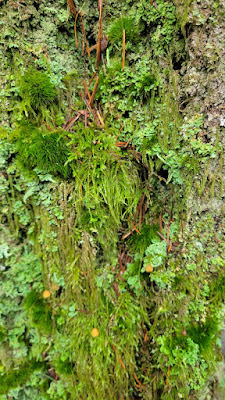"A close encounter with a mossy log always makes me think of entering a fantasy fabric shop. Its windows overflow with rich textures and colors that invite you closer to inspect the bolts of cloth arrayed before you."
— Robin Wall Kimmerer, Gathering Moss: A Natural and Cultural History*
I remember camping trips as a child with my parents and my younger sister walking through a forest in Oregon or Washington or northern California or British Columbia, loving the moss and deciding to bring some home to plant so I could grow it. I put a small patch of moss in a plastic cup, carefully keeping it damp all the way home, only to learn that mosses won't thrive in the hot weather of Lewiston, Idaho, a part of the state known as the "Banana Belt" for its long growing season (and distinct lack of evergreen forests).
"Mosses are not elevator music; they are the intertwined threads of a Beethoven quartet."
— Robin Wall Kimmerer
Here in Olympia in the sheltered inland marine climate of western Washington the mosses thrive. Every walk through Squaxin Park wraps me in their rich emerald softness. These tiniest of plants blanket logs, standing trees, the seemingly frail limbs of bushes, stones, the ground, the edges of curbs and stormwater access covers on the sidewalks leading to the park. I stop and step closer to a giant tree, my eyes trying to distinguish the different types twined together.
"...the already gorgeous world becomes even more beautiful the closer you look."
— Robin Wall Kimmerer
On a December walk in the park with my sweetheart, he commented on something I hadn't noticed before: The mosses are thick on the deciduous trees, while the trunks of the Western redcedar and other evergreens are for the most part bare of all but a pale green lichen, at least for the living trees. The bases of some evergreens have moss growing up from the ground but they don't appear to be the hospitable hosts that the big-leaf maples and other deciduous trees are.
Not long after moving close to Squaxin Park I discovered the Telephone of the Wind: an old-fashioned wall-mount rotary phone on a piece of plywood. The telephone is mounted next to a giant tree at the end of a short side trail that goes only to the tree and back again. Placed there in memory of four-year-old Joelle Sylvester, who died unexpectedly, the phone is a tangible symbol of reaching out to loved ones who have died. When you pick it up and place it to your ear the effect is similar to listening to a seashell: your ear detects a gentle sighing, something more than silence.
We moved to Olympia in fall 2020; back then I visited there to "talk" with my brother Don, who died too young in 2016. Since then my list of people to remember at the tree has grown, all of them people who died long before their time: my niece Amanda, my cousin's son Nate, my former stepson Alex.
Sometimes when I walk down the trail someone else is there, receiver pressed to their head, talking quietly and gently to someone they miss, and I turn around and leave them in peace. About two years ago I placed a small rock there I had painted with hearts. Other memorial leavings come and go; the park staff ask us to leave only natural materials. My heart rock remains, nestled on the ground with other gifts and surrounded by woods full of mosses, mosses everywhere.
Related Reading
- Why I Walk
- Walking Poems
- Walking in November: Of Perspectives and Pavement
- Walking in October: Of Travel and Timers
- Walking in September: Of Berries and Bunnies
- Walking in August: Of Sparkles and Shorelines
- Walking in July: Of Findings and Feathers
- Walking in June: Of Habits and Herons
- Walking in May: Of Downtowns and Dancing
- Walking in April: Of Multimodal Miles and Museums
- Walking in March: Of Woods and Work
- Walking in February: Of Woods and Water
- Walking in January: Of Gloves and Poetry





No comments :
Post a Comment
Comments are like karma. The more you give, the more you receive. (Spam is like karma too.)